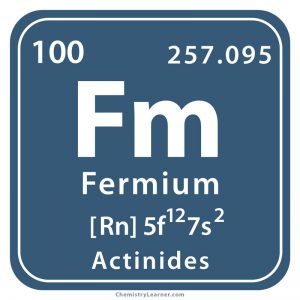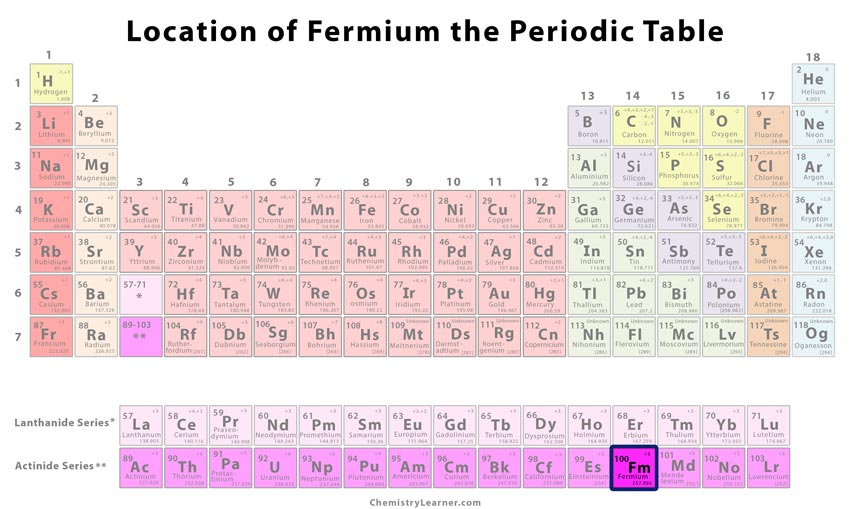Fermium
What is Fermium
Fermium (pronounced as FER-mee-em) [2] is a synthetic, transuranium, radioactive element [3] with the symbol Fm [1] belonging to the family of inner transition metals [10]. It has 18 isotopes with mass numbers ranging from 242 to 259 of which Fm-257 is the most stable isotope with a half-life of 100.5 days [2, 3]. It decays into californium-253 through alpha emission and spontaneous fission [2].
Where Is it Found
It cannot be found naturally on earth [3]. However, it can be obtained in microgram quantities by the neutron bombardment of plutonium in a nuclear reactor [1].
History of the Element
Origin of the Name: The element is named after the famous nuclear physicist Enrico Fermi [1].
Who Discovered it: It was discovered by a team of scientists led by Albert Ghiorso on October 31, 1952 [2, 3].
How was it Discovered
The first isotope of fermium (later named as fermium-255), was found in the nuclear debris after the thermonuclear explosion of the first hydrogen bomb (codenamed Ivy Mike [3, 10]) on an atoll in the Pacific Ocean [1]. It was because uranium-238, the source of heat for the detonation, was exposed to a flux of neutrons during the process and combined with 17 of them to produce Fm-255 that has a half-life of about 20 hours [1, 2].
It was later produced in the laboratory by a group at the Nobel Institute of Stockholm. They bombarded uranium-238 with oxygen nuclei producing fermium-250 with a half-life of 30 minutes [1].
Fermium Identification |
|||
| Atomic Number | 100 [2] | ||
| CAS Number | 7440-72-4 [1] | ||
| Position in the periodic table | Group: Actinides[1] | Period: 7 [1] | Block: f [1] |
Properties and Characteristics of Fermium
General Properties |
||
| Atomic mass | 257 atomic mass units [8,9] | |
| Mass number | 257 [5] | |
Physical Properties |
||
| Color/appearance | Unknown [3,7] | |
| Luster | Unknown [16] | |
| Texture | Unknown [14] | |
| Melting point/freezing point | 1527°C (2781°F) [1] | |
| Boiling point | Unknown [1] | |
| Density | Unknown [1] | |
| State of matter at room temperature (natural state) | Solid [1,2] | |
| Hardness | Unknown [12, 15] | |
Chemical Properties |
||
| Flammability | Unknown | |
| Oxidation state/Oxidation number | +2, +3 [1] | |
| Reactivity | Unknown [13] | |
Atomic Data of Fermium (Element 100)
| Valence electrons | 2 [4] | ||||||
| Quantum numbers | |||||||
| – n | 5 [4] | ||||||
| – ℓ | 3 [4] | ||||||
| – m ℓ | 1 [4] | ||||||
| – m s | -½ [4] | ||||||
| Electron configuration (noble gas configuration) | [Rn]5f127s2 [3] | ||||||
| Atomic structure | |||||||
| – Number of Electrons | 100 [3] | ||||||
| – Number of Neutrons | 157 [3] | ||||||
| – Number of Protons | 100 [3] | ||||||
| Energy levels | |||||||
| – First Energy Level | 2 [3] | ||||||
| – Second Energy Level | 8 [3] | ||||||
| – Third Energy Level | 18 [3] | ||||||
| – Fourth Energy Level | 32 [3] | ||||||
| – Fifth Energy Level | 30 [3] | ||||||
| – Sixth Energy Level | 8 [3] | ||||||
| – Seventh Energy Level | 2 [3] | ||||||
| Radius of atom | |||||||
| – Atomic Radius | 2.45 Å [1] | ||||||
| – Covalent Radius | 1.67 Å [1] | ||||||
| Electronegativity | 1.3 [6] | ||||||
| Ionization energy
(kJmol-1) [1] |
1st | 2nd | 3rd | 4th | 5th | 6th | 7th |
| 627.2 | – | – | – | – | – | – | |

Fermium Electronic Configuration (Bohr Model)
Uses of Fermium
Due to its minute production and short half-life, it is used for research purposes only [2].
Health Hazards
It is potentially dangerous due to its radioactivity [1].
Interesting Facts
- Fermium, along with Einsteinium, was one of the first synthetic elements produced after the testing of a hydrogen bomb [10, 15].
- As the hydrogen bomb testing was top secret, researchers could only publish the discovery of Fm in 1955 after producing it officially in a laboratory [1, 3, 10].
Cost of Fermium
Unavailable since it is not found naturally and only produced in nuclear reactors [3].
- References
- http://www.rsc.org/periodic-table/element/100/fermium
- https://education.jlab.org/itselemental/ele100.html
- https://www.chemicool.com/elements/fermium.html
- http://chemistry-reference.com/q_elements.asp?Symbol=Fm&language=en
- Pubchem.ncbi.nlm.nih.gov
- https://www.nuclear-power.net/fermium-affinity-electronegativity-ionization/
- http://www.elementalmatter.info/element-fermium.htm
- http://www.chemicalelements.com/elements/fm.html
- http://hobart.k12.in.us/ksms/PeriodicTable/fermium.htm
- https://study.com/academy/lesson/fermium-element-properties-uses-facts.html
- Lenntech.com
- http://periodictable.com/Elements/100/data.html
- https://www.webelements.com/fermium/chemistry.html
- http://www.answers.com/Q/What_is_the_texture_of_fermium
- https://www.schoolmykids.com/learn/interactive-periodic-table/Fm-Fermium/
- http://www.answers.com/Q/Is_the_element_fermium_luster
- http://large.stanford.edu/courses/2015/ph241/singh-a1/






